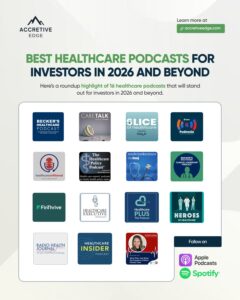Decision makers inside hospitals aren’t always spending time in vendor newsletters or branded nurture flows. They’re also reading Modern Healthcare, joining peer-led webinars, and hearing about solutions from people they trust.
Meanwhile, marketing budgets tend to lean into what feels effective — daily social posts, demo-heavy webinars, and white papers. And while those are good starting points, if those assets underperform, the default response tends to be: publish more.
But it might be a placement problem, not a volume one. In most cases, the distribution plan needs to better reflect how hospital buyers actually operate.
In this piece, we’ll lay out what healthcare content distribution channels are working for economic, technology, and clinical buyers — with tactical recommendations for where to invest, what to publish, and how to show up credibly.
Top Healthcare Content Distribution Channels
If you’re trying to reach hospital buyers in 2025, where you publish matters more than how much you publish.
Below are the channels that consistently earn attention. These are not just high-reach platforms, but high-trust platforms. That distinction is key.
1. Industry Publications and Trade Journals
This is still one of the most underutilized channels relative to its influence.
80% of hospital CIOs rely on trade publications, journals, or association media for vendor discovery and industry news. Publications like Becker’s, Modern Healthcare, HealthLeaders, JAMA, and NEJM remain common sources for hospital and clinical leaders.
These outlets carry built-in credibility. A byline in Healthcare IT News may outperform ten blog posts on your company’s website — not because your content isn’t credible, but because the channel is. Vendors often default to paid ad campaigns or social promotions when earned media could serve them better. Especially at the top of the funnel.
2. Conferences and In-Person Events
Despite the rise of digital channels, nothing replaces peer-to-peer exposure in a trusted room.
75% of CIOs say they obtain product/vendor information from healthcare events like HIMSS, CHIME, and HLTH. For clinical and finance leaders, the same dynamic applies. Think: Healthcare Financial Management Association (HFMA) for CFOs, specialty society meetings for clinicians.
In-person trust might even beat even peer recommendations in some cases. This doesn’t mean physical booths are always worth the spend — but showing up with smart speakers, panelists, or customer-led presentations often is.
3. LinkedIn (Especially for CIOs and Emerging Clinicians)
LinkedIn isn’t just a hiring platform. It’s where a large portion of hospital leaders track trends, engage with peer voices, and discover vendors organically.
- Over 110,000 healthcare CXOs and 8 million U.S. healthcare professionals are active on LinkedIn.
- Around 40% of CIOs use social media (including LinkedIn) for industry news and insight consumption.
Where this channel works best is not organic thought leadership posts alone, but in pairing those posts with highly targeted distribution (like Thought Leader Ads, and LinkedIn ABM). Sponsored content, direct outreach by job title and org type, and strategic use of peer engagement (likes, reshares, and comments from known industry names) is where actual visibility lives. Dig into a few LinkedIn post ideas for healthcare leaders and dive deeper into the importance of owned media.
4. Webinars and Virtual Events
Despite fatigue, webinars are still one of the most consistently effective formats — if you do them right.
60% of CIOs say webinars are among their top content sources when researching new technologies. Also, CFOs and clinicians follow close behind — especially when panels include peer operators, not just vendor voices.
The most common mistake is hosting a “webinar” that’s actually a veiled sales pitch. These tend to underperform. What works: live panels, short-run series by role (e.g. CMIO talks with CMIOs), or high-signal sessions with respected Key Opinion Leaders (KOLs). Bonus points for offering Continuing Medical Education (CME) credit to clinicians or real-world ROI walkthroughs for CFOs. Learn more about webinar planning ahead of your next event.
5. Peer Referrals
You can’t buy this — but you can build toward it.
90% of CIOs say peer endorsements and expert referrals influence their purchasing decisions. Clinicians and CFOs often respond to peer-to-peer credibility possibly more than branded marketing.
Customer-led case studies, client-to-client referral paths, or speaker slots for existing customers do more to build trust than another blog series. If your happiest customers aren’t featured in your content, your distribution strategy is missing its strongest asset. See our Analyst Relations and Commercialization Gap white papers for examples of how to do this in your content.
6. Vendor Websites and Blogs
Not the most glamorous — but still essential. Most buyers are 70% through their decision-making process before they ever talk to sales.
When they arrive at your website, they’re looking for one thing: confirmation that you’re credible. Your site should function like a searchable case library, not a product brochure. Optimized for mobile, loaded with testimonials, and built around questions real buyers are asking.
7. Podcasts
Still a dark horse, but one worth watching. 20% of CIOs regularly listen to professional podcasts. Also, among physicians under 40, podcasts ranked 4th out of 13 formats for media consumption in a 2024 survey.
Use this for clinical thought leadership, origin stories, or customer narratives. And don’t underestimate its reach — especially among emerging leaders who don’t yet get invited to conferences but still shape influence from below.
Tailoring Content for Hospital Decision-Makers
Getting your content into the right channel is only half the work. The other half is understanding how each type of hospital buyer thinks — and aligning the message accordingly.
There’s no one-size-fits-all playbook. A finance leader doesn’t evaluate content the same way a CMIO does. A nursing executive may value outcomes that never show up in a case study built for a CIO.
To earn attention — and trust — the content has to reflect the way each audience processes risk, value, and relevance.
Economic Buyers (CFOs)
CFOs are scanning for cost containment, risk mitigation, and revenue upside. They don’t have time for fluff, and they’re not clicking through social posts for inspiration. What they’re looking for are proof points they can drop into a budget review.
They’ll spend time with a white paper — but only if it offers actual benchmarks, not brand positioning. What gets their attention:
- Financial outcome data from comparable institutions
- ROI calculators or visuals that clarify total cost of ownership
- Peer panels hosted by HFMA or recaps in Modern Healthcare
The mistake some vendors make is treating the CFO like an influencer in the buying process. They’re not. They’re the gatekeeper — and if the math doesn’t check out, the conversation usually ends there.
Technology Buyers (CIOs, CMIOs, CTOs)
This group is operating in a noisy ecosystem, flooded with vendor pitches. What they’re scanning for isn’t just the vision, but the execution.
Concise, role-aware content tends to perform best. A CIO may not read a ten-page white paper, but will study a two-minute video walkthrough of a successful integration at a similar-sized health system. CMIOs want clinical workflow impact. CTOs are listening for security, interoperability, and scalability.
Here’s where content tends to land well:
- Short-form case studies with real results
- Webinars that feature peer voices, not just vendor sales leads
- Snippets distributed through Becker’s IT, Healthcare IT News, or curated LinkedIn threads
And here’s what underperforms: email sequences full of jargon, white papers without technical depth, or webinars that open with a product demo.
CIOs, in particular, are not looking to be educated on trends. They’re looking to see who’s already solved the problem they’re working on.
Clinical Buyers (CMOs, CNOs, Physician Leaders)
Clinicians trust evidence, not messaging. They want to know what worked — and who says so.
Most of the time, they’re not reading your blog or opening cold outreach. But if a respected peer is presenting results at a specialty society meeting, they’re paying attention. They’ll also make time for a CME-accredited webinar, a case study published in JAMA, or a Medscape feature that lays out outcomes tied to a similar patient population.
That doesn’t mean clinical content has to be long-form or academic. In fact, younger physicians are increasingly engaging with:
- Podcasts that feature interviews with clinicians or CMOs
- LinkedIn discussions around clinical operations or care delivery trends
- Peer-authored case studies with visual outcome summaries
The common thread: the source matters more than the style. A credible voice can carry your story much further than a branded slide deck ever will.
Every buyer group consumes content differently. But across all three, the same principle applies: if it doesn’t reflect their world, language, and decision calculus — it’s not moving the needle.
Alignment Beats Volume in Healthcare Content Marketing
There’s a lot of pressure in healthcare content marketing to publish more. But more content, in more places, doesn’t move the needle if it’s not connected to real media habits. The better approach might be to know how many of your top prospects actually saw the last thing you published — and if they’d call it useful.
In a crowded market, alignment beats volume. And presence — in the places where trust already lives — matters more than perfection.
Many teams we work with aren’t struggling to create strong content — they struggle to connect it to a digital health marketing strategy that actually reaches the people holding the budget. That’s usually not a creative issue, but a GTM issue.
If your distribution still looks like it did two quarters ago, it might be time to recalibrate. Get in touch — happy to compare notes.






